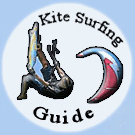Rescue Techniques
Anyone who wants to do kitesurfing should be able to rescue himself or other kitesurfers in danger. Even other people in the water that aren’t doing kitesurfing must be rescued in case of emergency. Here are some of the techniques used if something bad occurs:
Self-rescue Techniques:
Use the power of your still flying kite to pull you and your board back to the beach. So make sure that there is a good beach in the way you are going, as doing this will make you go around 60 degrees downwind either to the left or to the right. That is why it is very important to always have a friendly beach downwind from the starting point.
In case of light wind, bridle mixed up, broken battens, broken lines or water leak your kite may still be on the water , but you cannot launch it. In this situation, you have to wind all the lines in. to be sure that your kite does not get accidentally relaunched while winding the lines in, and if you have an inflatable or closed cell foil kite, you need to reel in with 1 line 10 - 12' out-of-sync of the other. Should you have a reel bar, to pull the left line 20'; reel both lines in 10' while holding the left line at 20’ position, then pull the left line another 10' and continue to reel both lines in while holding the left line.
Use an inflatable kite just like using a sail to get to a beach. Hold the kite bridle with both hands, after wounding all the lines in. Chances are that you can only go around 60 degrees downwind either to the left or to the right, so it would be quite a relief having a nice beach in sight.
In case the water has gotten into your foil, use the bridle to relaunch the foil. You have to park the kite on one side in order to get to a beach.
Should you own an inflatable kite, but yet there is no wind, you must swim to shore, holding at the same time the kite with one hand. You may also hold the board with the other hand.
If the wind is pushing your inflatable kite off shore or if you have any other kite type, you have to pack your kite. In case you have a ram foil kite, you have to pack it by folding both wind tips together a number of time until around 3', 4' and then rolling the kite from the trailing edge toward the leading edge. On the other hand, should you own an inflatable kite, the packing way is pretty much the same, the single difference being the fact that you have to deflate all the inflatable tubes completely before packing your kite. Finally, should you use a framed kite, you must pack the kite instructions that came with the kite tell you to.
The packed kite must be placed on top of the board. Then you can swim towards the beach holding the board with both hands in front of you. An idea would be to hold the board and the kite with one hand on the side, or you can on top of your board and paddle to shore, this being possible only if the board is big.
Rescue Techniques:
1. in order for you to rescue another kitesurfer, he must pack his board himself. Try to keep his side, and stay in an area of 1 mile with him while he does the packing.
2. stop near the other surfer, providing that he has finished packing the board. It is important that he has wound all the lines completely. Help the kitesurfer place his packed kite on your board and then hold your board with both hands so that you can use the power of your kite to pull both you and the other kitesurfer to the beach. You should know whether there is a beach in the vicinity , as you can only go around 60 degrees downwind either to the left or to the right.
3. another rescue method that is quite similar to the previous one is the one to use in case you have to rescue other people in the water. This is useful only if they are able to pack their equipment on the water and can hold on to both your board and their things with both hands.


